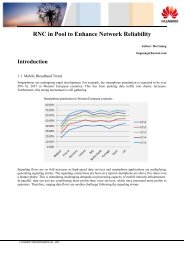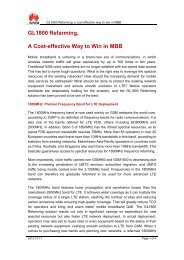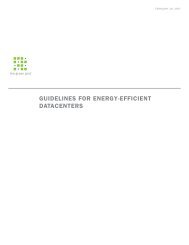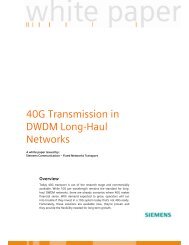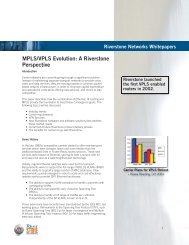Welcome to the Human Network - Light Reading
Welcome to the Human Network - Light Reading
Welcome to the Human Network - Light Reading
You also want an ePaper? Increase the reach of your titles
YUMPU automatically turns print PDFs into web optimized ePapers that Google loves.
Cisco VQE offers service providers <strong>the</strong> following benefits:<br />
Video Error Repair<br />
Cisco VQE enables providers <strong>to</strong> precondition DSL lines for advanced video services<br />
such as IPTV by detecting and repairing packet loss on degraded copper lines. With<br />
this technology, a set-<strong>to</strong>p box (STB) detecting packet loss, requests a retransmission<br />
while holding <strong>the</strong> video sequence in queue. The Cisco VQE technology au<strong>to</strong>matically<br />
repairs <strong>the</strong> error by transmitting <strong>the</strong> missing packet, which is re-sequenced by <strong>the</strong> STB<br />
without interruption. The entire error repair cycle takes place in less than 100 ms, and is<br />
imperceptible <strong>to</strong> <strong>the</strong> viewer.<br />
Rapid Channel Change<br />
A transparent channel-change experience is a critical determinant of <strong>the</strong> subscriber’s<br />
visual experience. Cisco VQE standard-based fast channel-change technology<br />
reduces channel-change times from several seconds <strong>to</strong> less than 1 second by initiating<br />
video streams in less than 100 ms after a request is made. This technology works in<br />
conjunction with STBs <strong>to</strong> detect and accelerate channel-change requests. The result is<br />
<strong>to</strong>tally transparent <strong>to</strong> <strong>the</strong> viewer, who sees an uninterrupted channel change followed by<br />
successive video motion.<br />
Video Connection Admission Control (CAC)<br />
Occasional peaks in traffic usage can dramatically affect video quality. A single incremental<br />
access request for high-demand broadcast channels or VoD, if permitted, can disrupt<br />
<strong>the</strong> viewing experience for that entire community of viewers because network bandwidth<br />
becomes oversubscribed. Comprehensive and reliable admission control can help<br />
preserve <strong>the</strong> viewing experience for all subscribers.<br />
By employing in-path utilization analysis that quickly and accurately tracks network<br />
bandwidth, Cisco Video CAC prevents initiation of a request when it is determined that <strong>the</strong><br />
network lacks <strong>the</strong> capacity <strong>to</strong> carry <strong>the</strong> video stream <strong>to</strong> a subscriber. Subscriber notification<br />
is provided <strong>to</strong> gracefully delay a service request, and simultaneously preserve <strong>the</strong> visual<br />
experience for all o<strong>the</strong>r subscribers. A complementary off-path process prevents a video<br />
on-demand stream from being sent if <strong>the</strong> access link <strong>to</strong> <strong>the</strong> subscriber lacks <strong>the</strong> capacity<br />
<strong>to</strong> carry <strong>the</strong> stream. In this approach, <strong>the</strong> VoD server communicates with <strong>the</strong> Cisco BPM<br />
(policy server), which keeps track of <strong>the</strong> subscriber access links.<br />
Video Quality-Moni<strong>to</strong>ring Module<br />
The Cisco <strong>Network</strong> Analysis Module moni<strong>to</strong>rs video streams in real time and sends<br />
proactive alerts <strong>to</strong> providers if picture quality is degraded, enabling <strong>the</strong>m <strong>to</strong> determine <strong>the</strong><br />
cause of <strong>the</strong> degradation and correct it before call centers are overwhelmed.<br />
Employing Layer 3 in <strong>the</strong> video distribution network takes advantage of Pro<strong>to</strong>col<br />
Independent Multicast (PIM) with Source Specific Multicast (SSM) and Interior Gateway<br />
Pro<strong>to</strong>col (IGP) enhancements that enable fast network-level convergence for greater<br />
network efficiency and scale. More importantly, <strong>the</strong>se Layer 3 fast convergence techniques<br />
provide consistent subsecond network and application recovery for all failure modes,<br />
fur<strong>the</strong>r ensuring <strong>the</strong> visual experience for video subscribers.







